Analysis of Branding Strategy Role and Concepts in Virgin Group
VerifiedAdded on 2019/12/03
|17
|2994
|223
Report
AI Summary
This report delves into the branding strategies of the Virgin Group, examining the role and concepts that underpin its success. It begins with an executive summary and an introduction outlining the aims, objectives, and background of the study, including the significance of branding and its impact on customer perception. The report then proceeds with a literature review, exploring existing research on branding and its concepts such as brand attributes, personality, and promise. A case study of the Virgin Group is presented, followed by a discussion of research methodology, which includes an exploratory method and an inductive approach using secondary data. The findings are analyzed to assess the importance of branding in Virgin Group’s diversification efforts and brand equity. The report concludes with recommendations for effective branding strategies to achieve a competitive edge in the market, contributing to the understanding of branding's role in business growth and expansion. The research also addresses the role of brand equity in the company's development strategy and provides recommendations for future branding tactics.
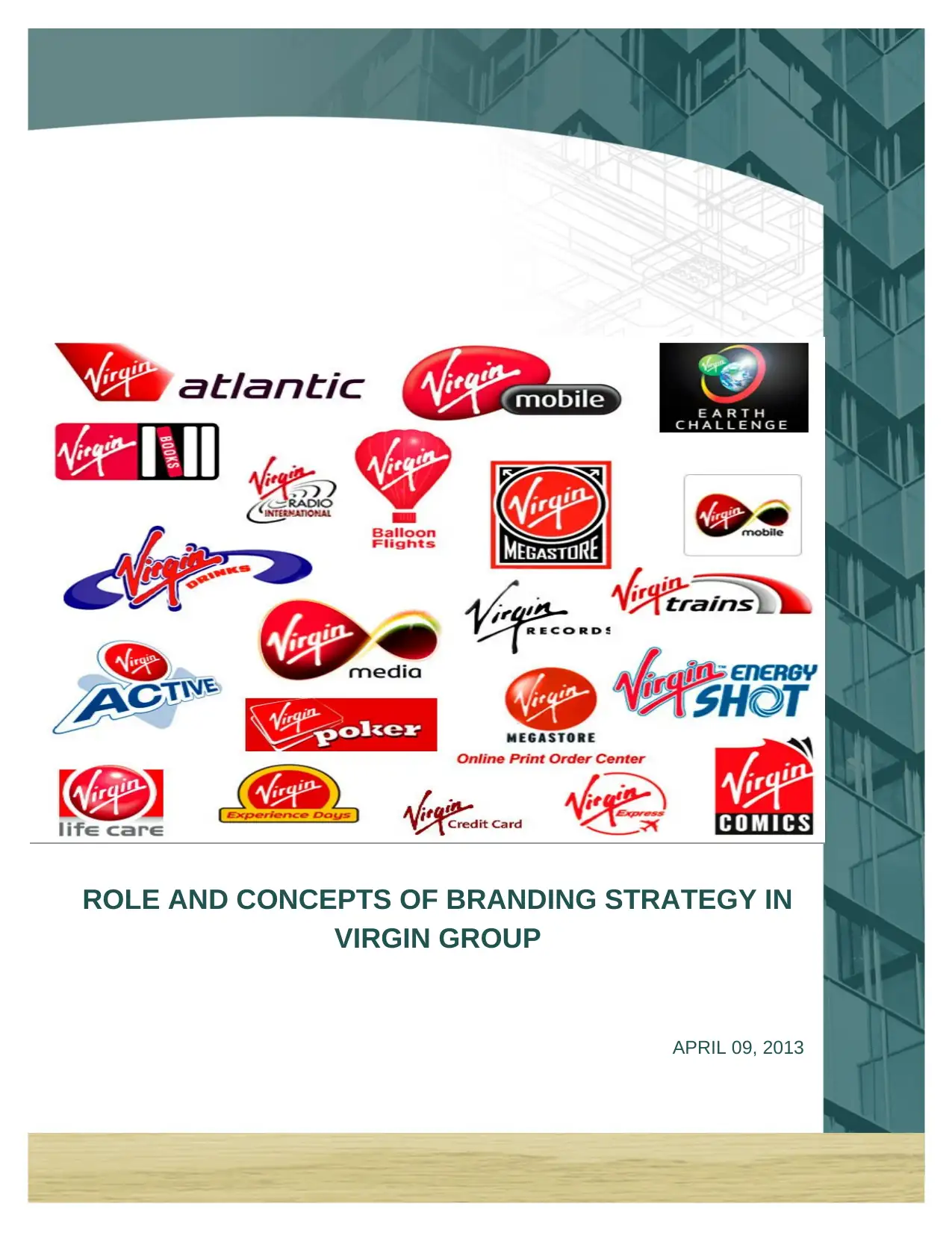
ROLE AND CONCEPTS OF BRANDING STRATEGY IN
VIRGIN GROUP
APRIL 09, 2013
VIRGIN GROUP
APRIL 09, 2013
Paraphrase This Document
Need a fresh take? Get an instant paraphrase of this document with our AI Paraphraser
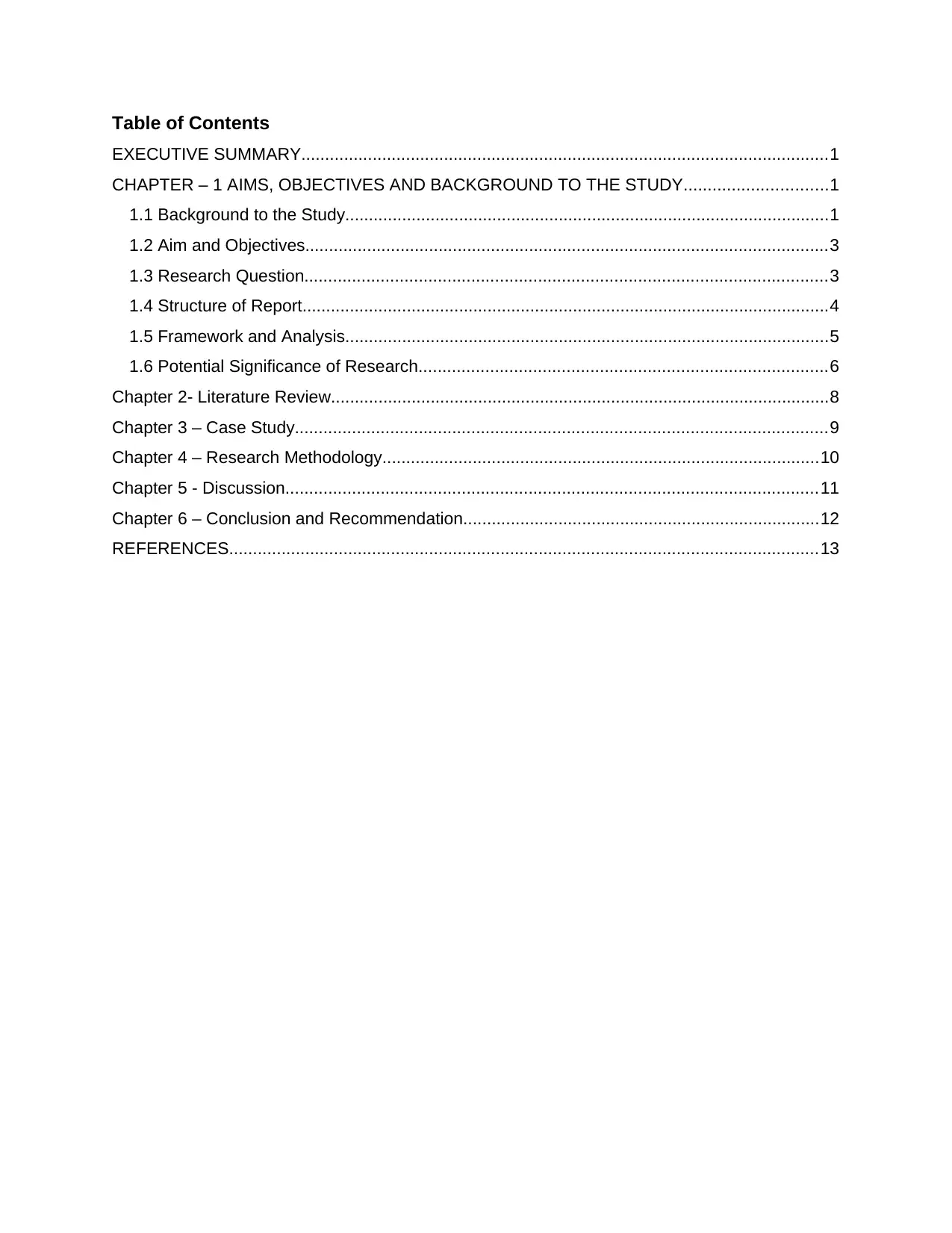
Table of Contents
EXECUTIVE SUMMARY...............................................................................................................1
CHAPTER – 1 AIMS, OBJECTIVES AND BACKGROUND TO THE STUDY..............................1
1.1 Background to the Study......................................................................................................1
1.2 Aim and Objectives..............................................................................................................3
1.3 Research Question..............................................................................................................3
1.4 Structure of Report...............................................................................................................4
1.5 Framework and Analysis......................................................................................................5
1.6 Potential Significance of Research......................................................................................6
Chapter 2- Literature Review.........................................................................................................8
Chapter 3 – Case Study................................................................................................................9
Chapter 4 – Research Methodology............................................................................................10
Chapter 5 - Discussion................................................................................................................11
Chapter 6 – Conclusion and Recommendation...........................................................................12
REFERENCES............................................................................................................................13
EXECUTIVE SUMMARY...............................................................................................................1
CHAPTER – 1 AIMS, OBJECTIVES AND BACKGROUND TO THE STUDY..............................1
1.1 Background to the Study......................................................................................................1
1.2 Aim and Objectives..............................................................................................................3
1.3 Research Question..............................................................................................................3
1.4 Structure of Report...............................................................................................................4
1.5 Framework and Analysis......................................................................................................5
1.6 Potential Significance of Research......................................................................................6
Chapter 2- Literature Review.........................................................................................................8
Chapter 3 – Case Study................................................................................................................9
Chapter 4 – Research Methodology............................................................................................10
Chapter 5 - Discussion................................................................................................................11
Chapter 6 – Conclusion and Recommendation...........................................................................12
REFERENCES............................................................................................................................13

EXECUTIVE SUMMARY
1
1
⊘ This is a preview!⊘
Do you want full access?
Subscribe today to unlock all pages.

Trusted by 1+ million students worldwide
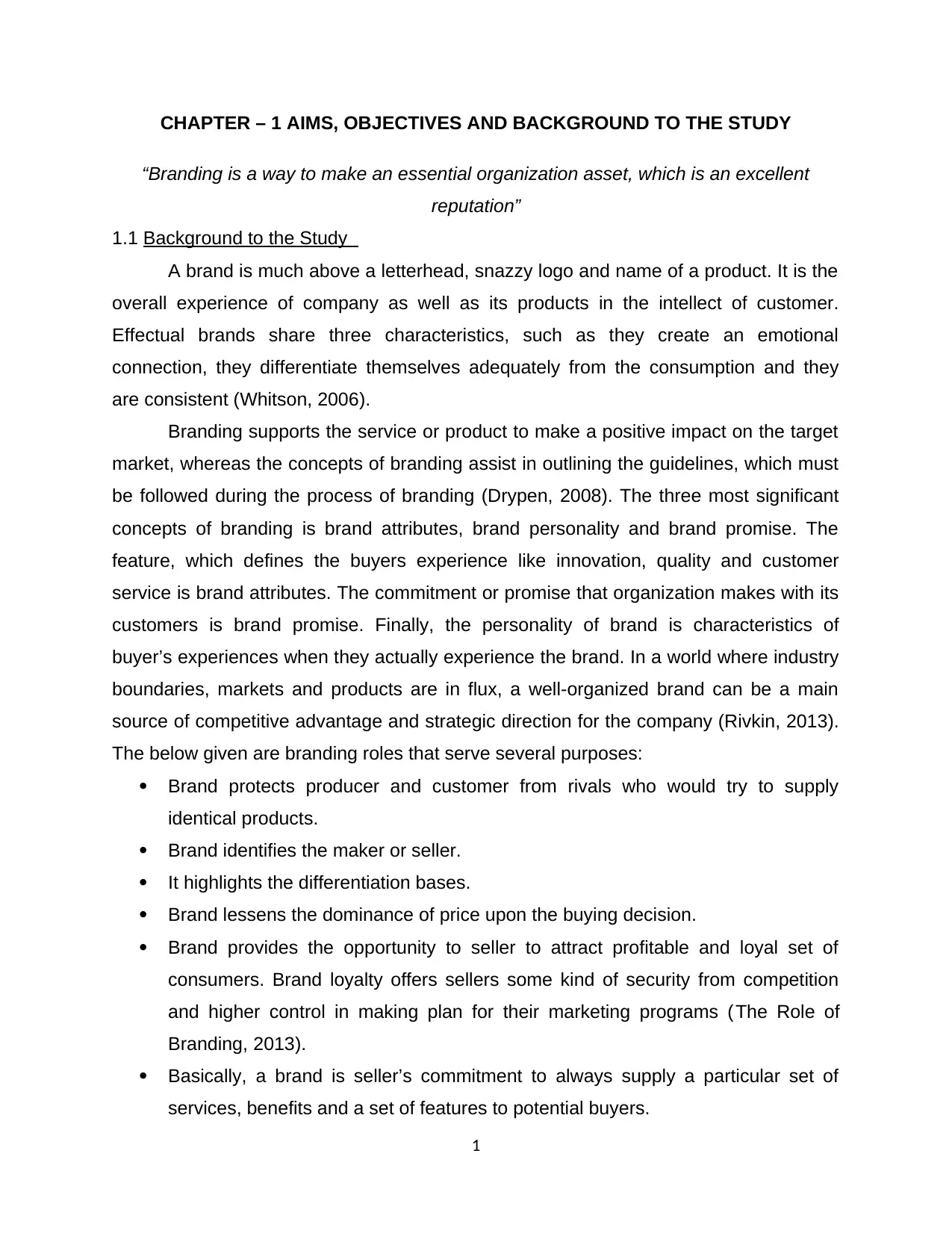
CHAPTER – 1 AIMS, OBJECTIVES AND BACKGROUND TO THE STUDY
“Branding is a way to make an essential organization asset, which is an excellent
reputation”
1.1 Background to the Study
A brand is much above a letterhead, snazzy logo and name of a product. It is the
overall experience of company as well as its products in the intellect of customer.
Effectual brands share three characteristics, such as they create an emotional
connection, they differentiate themselves adequately from the consumption and they
are consistent (Whitson, 2006).
Branding supports the service or product to make a positive impact on the target
market, whereas the concepts of branding assist in outlining the guidelines, which must
be followed during the process of branding (Drypen, 2008). The three most significant
concepts of branding is brand attributes, brand personality and brand promise. The
feature, which defines the buyers experience like innovation, quality and customer
service is brand attributes. The commitment or promise that organization makes with its
customers is brand promise. Finally, the personality of brand is characteristics of
buyer’s experiences when they actually experience the brand. In a world where industry
boundaries, markets and products are in flux, a well-organized brand can be a main
source of competitive advantage and strategic direction for the company (Rivkin, 2013).
The below given are branding roles that serve several purposes:
Brand protects producer and customer from rivals who would try to supply
identical products.
Brand identifies the maker or seller.
It highlights the differentiation bases.
Brand lessens the dominance of price upon the buying decision.
Brand provides the opportunity to seller to attract profitable and loyal set of
consumers. Brand loyalty offers sellers some kind of security from competition
and higher control in making plan for their marketing programs (The Role of
Branding, 2013).
Basically, a brand is seller’s commitment to always supply a particular set of
services, benefits and a set of features to potential buyers.
1
“Branding is a way to make an essential organization asset, which is an excellent
reputation”
1.1 Background to the Study
A brand is much above a letterhead, snazzy logo and name of a product. It is the
overall experience of company as well as its products in the intellect of customer.
Effectual brands share three characteristics, such as they create an emotional
connection, they differentiate themselves adequately from the consumption and they
are consistent (Whitson, 2006).
Branding supports the service or product to make a positive impact on the target
market, whereas the concepts of branding assist in outlining the guidelines, which must
be followed during the process of branding (Drypen, 2008). The three most significant
concepts of branding is brand attributes, brand personality and brand promise. The
feature, which defines the buyers experience like innovation, quality and customer
service is brand attributes. The commitment or promise that organization makes with its
customers is brand promise. Finally, the personality of brand is characteristics of
buyer’s experiences when they actually experience the brand. In a world where industry
boundaries, markets and products are in flux, a well-organized brand can be a main
source of competitive advantage and strategic direction for the company (Rivkin, 2013).
The below given are branding roles that serve several purposes:
Brand protects producer and customer from rivals who would try to supply
identical products.
Brand identifies the maker or seller.
It highlights the differentiation bases.
Brand lessens the dominance of price upon the buying decision.
Brand provides the opportunity to seller to attract profitable and loyal set of
consumers. Brand loyalty offers sellers some kind of security from competition
and higher control in making plan for their marketing programs (The Role of
Branding, 2013).
Basically, a brand is seller’s commitment to always supply a particular set of
services, benefits and a set of features to potential buyers.
1
Paraphrase This Document
Need a fresh take? Get an instant paraphrase of this document with our AI Paraphraser
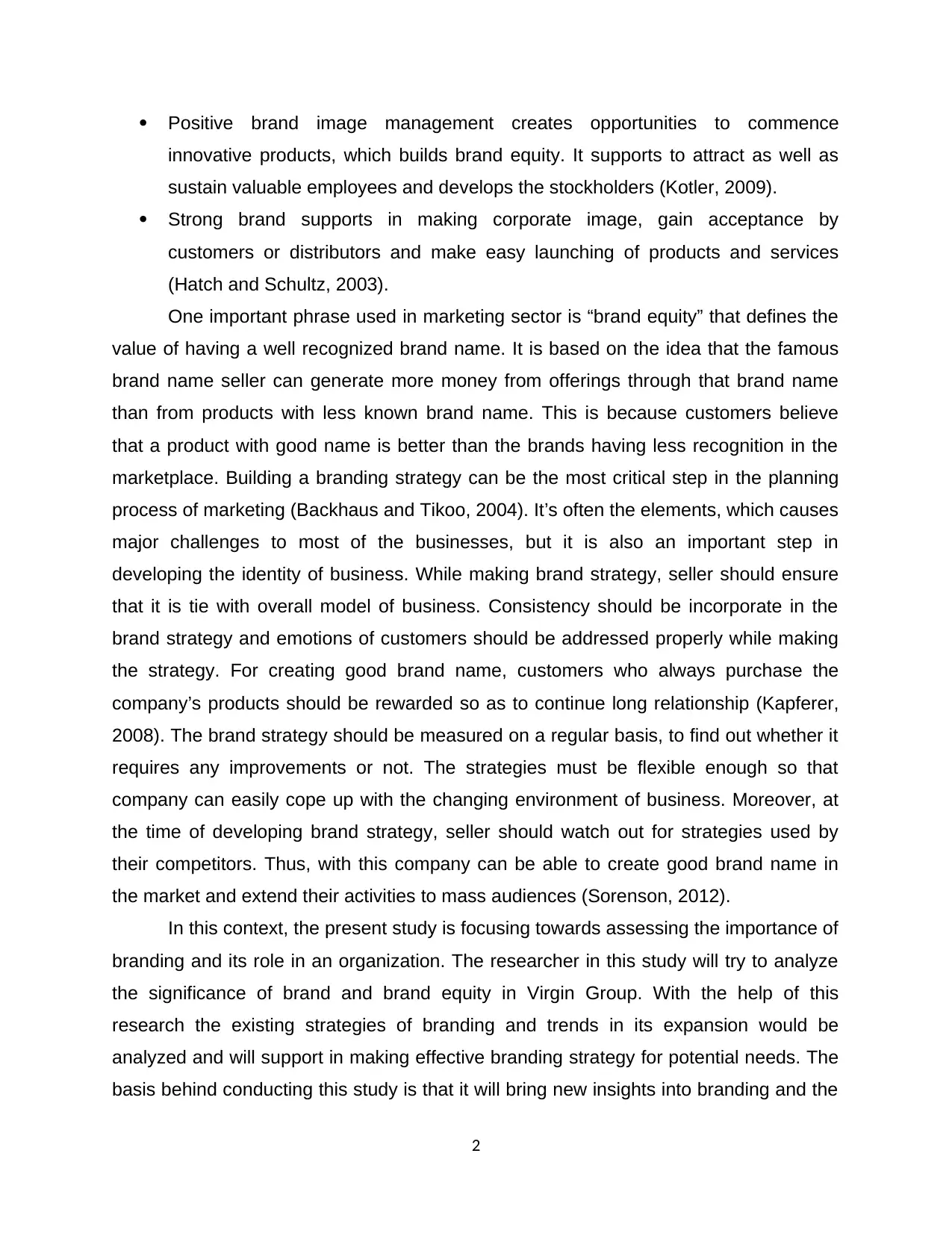
Positive brand image management creates opportunities to commence
innovative products, which builds brand equity. It supports to attract as well as
sustain valuable employees and develops the stockholders (Kotler, 2009).
Strong brand supports in making corporate image, gain acceptance by
customers or distributors and make easy launching of products and services
(Hatch and Schultz, 2003).
One important phrase used in marketing sector is “brand equity” that defines the
value of having a well recognized brand name. It is based on the idea that the famous
brand name seller can generate more money from offerings through that brand name
than from products with less known brand name. This is because customers believe
that a product with good name is better than the brands having less recognition in the
marketplace. Building a branding strategy can be the most critical step in the planning
process of marketing (Backhaus and Tikoo, 2004). It’s often the elements, which causes
major challenges to most of the businesses, but it is also an important step in
developing the identity of business. While making brand strategy, seller should ensure
that it is tie with overall model of business. Consistency should be incorporate in the
brand strategy and emotions of customers should be addressed properly while making
the strategy. For creating good brand name, customers who always purchase the
company’s products should be rewarded so as to continue long relationship (Kapferer,
2008). The brand strategy should be measured on a regular basis, to find out whether it
requires any improvements or not. The strategies must be flexible enough so that
company can easily cope up with the changing environment of business. Moreover, at
the time of developing brand strategy, seller should watch out for strategies used by
their competitors. Thus, with this company can be able to create good brand name in
the market and extend their activities to mass audiences (Sorenson, 2012).
In this context, the present study is focusing towards assessing the importance of
branding and its role in an organization. The researcher in this study will try to analyze
the significance of brand and brand equity in Virgin Group. With the help of this
research the existing strategies of branding and trends in its expansion would be
analyzed and will support in making effective branding strategy for potential needs. The
basis behind conducting this study is that it will bring new insights into branding and the
2
innovative products, which builds brand equity. It supports to attract as well as
sustain valuable employees and develops the stockholders (Kotler, 2009).
Strong brand supports in making corporate image, gain acceptance by
customers or distributors and make easy launching of products and services
(Hatch and Schultz, 2003).
One important phrase used in marketing sector is “brand equity” that defines the
value of having a well recognized brand name. It is based on the idea that the famous
brand name seller can generate more money from offerings through that brand name
than from products with less known brand name. This is because customers believe
that a product with good name is better than the brands having less recognition in the
marketplace. Building a branding strategy can be the most critical step in the planning
process of marketing (Backhaus and Tikoo, 2004). It’s often the elements, which causes
major challenges to most of the businesses, but it is also an important step in
developing the identity of business. While making brand strategy, seller should ensure
that it is tie with overall model of business. Consistency should be incorporate in the
brand strategy and emotions of customers should be addressed properly while making
the strategy. For creating good brand name, customers who always purchase the
company’s products should be rewarded so as to continue long relationship (Kapferer,
2008). The brand strategy should be measured on a regular basis, to find out whether it
requires any improvements or not. The strategies must be flexible enough so that
company can easily cope up with the changing environment of business. Moreover, at
the time of developing brand strategy, seller should watch out for strategies used by
their competitors. Thus, with this company can be able to create good brand name in
the market and extend their activities to mass audiences (Sorenson, 2012).
In this context, the present study is focusing towards assessing the importance of
branding and its role in an organization. The researcher in this study will try to analyze
the significance of brand and brand equity in Virgin Group. With the help of this
research the existing strategies of branding and trends in its expansion would be
analyzed and will support in making effective branding strategy for potential needs. The
basis behind conducting this study is that it will bring new insights into branding and the
2
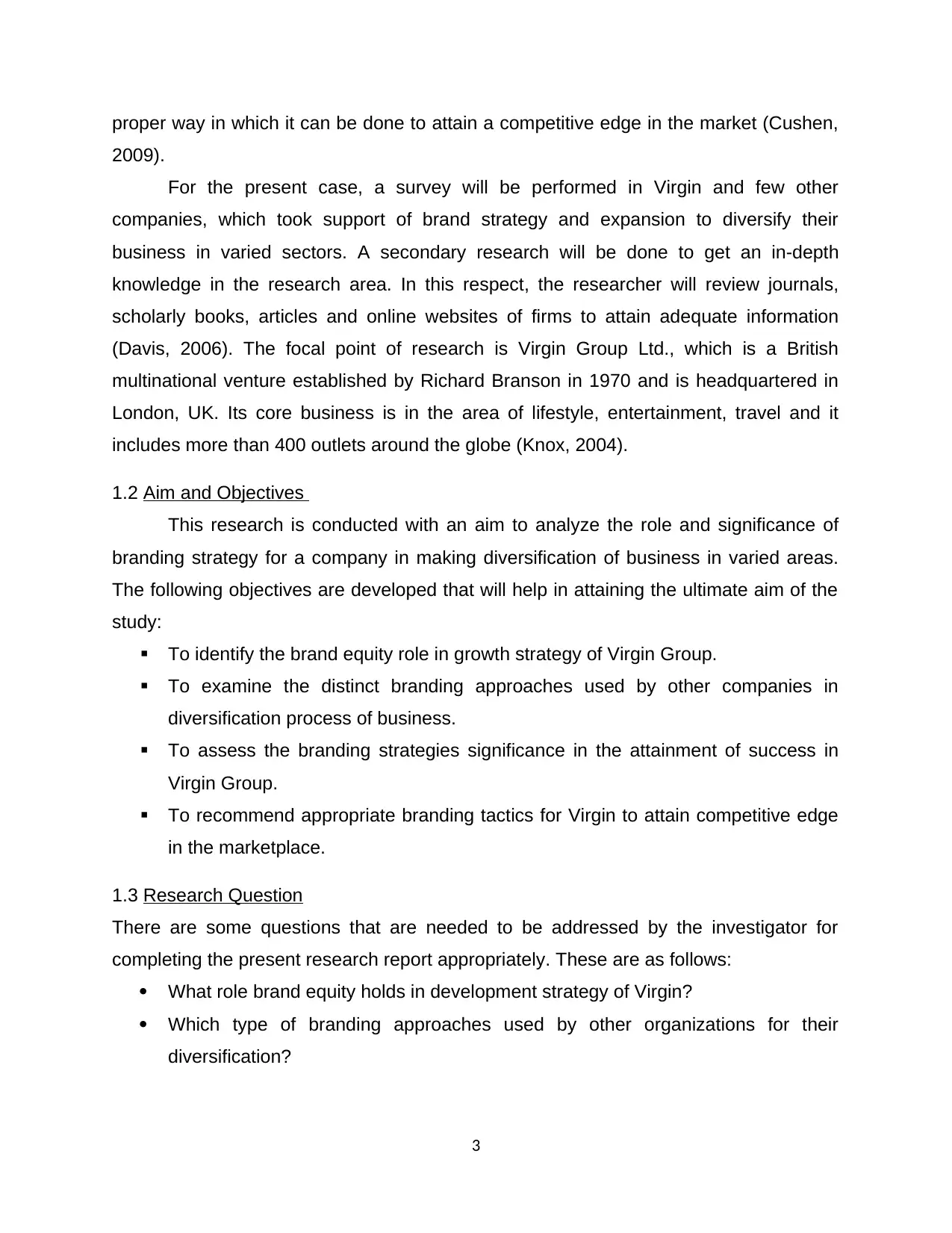
proper way in which it can be done to attain a competitive edge in the market (Cushen,
2009).
For the present case, a survey will be performed in Virgin and few other
companies, which took support of brand strategy and expansion to diversify their
business in varied sectors. A secondary research will be done to get an in-depth
knowledge in the research area. In this respect, the researcher will review journals,
scholarly books, articles and online websites of firms to attain adequate information
(Davis, 2006). The focal point of research is Virgin Group Ltd., which is a British
multinational venture established by Richard Branson in 1970 and is headquartered in
London, UK. Its core business is in the area of lifestyle, entertainment, travel and it
includes more than 400 outlets around the globe (Knox, 2004).
1.2 Aim and Objectives
This research is conducted with an aim to analyze the role and significance of
branding strategy for a company in making diversification of business in varied areas.
The following objectives are developed that will help in attaining the ultimate aim of the
study:
To identify the brand equity role in growth strategy of Virgin Group.
To examine the distinct branding approaches used by other companies in
diversification process of business.
To assess the branding strategies significance in the attainment of success in
Virgin Group.
To recommend appropriate branding tactics for Virgin to attain competitive edge
in the marketplace.
1.3 Research Question
There are some questions that are needed to be addressed by the investigator for
completing the present research report appropriately. These are as follows:
What role brand equity holds in development strategy of Virgin?
Which type of branding approaches used by other organizations for their
diversification?
3
2009).
For the present case, a survey will be performed in Virgin and few other
companies, which took support of brand strategy and expansion to diversify their
business in varied sectors. A secondary research will be done to get an in-depth
knowledge in the research area. In this respect, the researcher will review journals,
scholarly books, articles and online websites of firms to attain adequate information
(Davis, 2006). The focal point of research is Virgin Group Ltd., which is a British
multinational venture established by Richard Branson in 1970 and is headquartered in
London, UK. Its core business is in the area of lifestyle, entertainment, travel and it
includes more than 400 outlets around the globe (Knox, 2004).
1.2 Aim and Objectives
This research is conducted with an aim to analyze the role and significance of
branding strategy for a company in making diversification of business in varied areas.
The following objectives are developed that will help in attaining the ultimate aim of the
study:
To identify the brand equity role in growth strategy of Virgin Group.
To examine the distinct branding approaches used by other companies in
diversification process of business.
To assess the branding strategies significance in the attainment of success in
Virgin Group.
To recommend appropriate branding tactics for Virgin to attain competitive edge
in the marketplace.
1.3 Research Question
There are some questions that are needed to be addressed by the investigator for
completing the present research report appropriately. These are as follows:
What role brand equity holds in development strategy of Virgin?
Which type of branding approaches used by other organizations for their
diversification?
3
⊘ This is a preview!⊘
Do you want full access?
Subscribe today to unlock all pages.

Trusted by 1+ million students worldwide
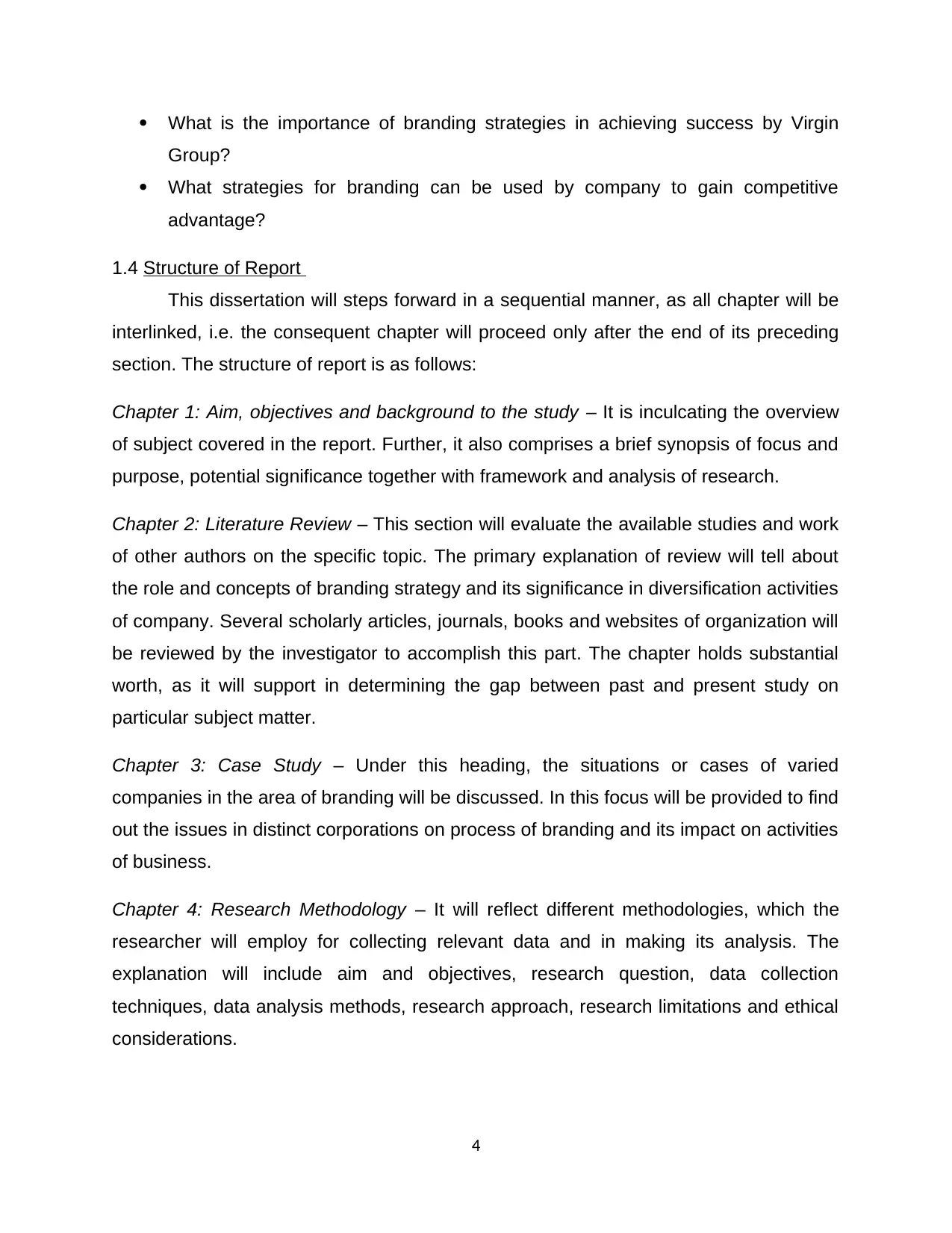
What is the importance of branding strategies in achieving success by Virgin
Group?
What strategies for branding can be used by company to gain competitive
advantage?
1.4 Structure of Report
This dissertation will steps forward in a sequential manner, as all chapter will be
interlinked, i.e. the consequent chapter will proceed only after the end of its preceding
section. The structure of report is as follows:
Chapter 1: Aim, objectives and background to the study – It is inculcating the overview
of subject covered in the report. Further, it also comprises a brief synopsis of focus and
purpose, potential significance together with framework and analysis of research.
Chapter 2: Literature Review – This section will evaluate the available studies and work
of other authors on the specific topic. The primary explanation of review will tell about
the role and concepts of branding strategy and its significance in diversification activities
of company. Several scholarly articles, journals, books and websites of organization will
be reviewed by the investigator to accomplish this part. The chapter holds substantial
worth, as it will support in determining the gap between past and present study on
particular subject matter.
Chapter 3: Case Study – Under this heading, the situations or cases of varied
companies in the area of branding will be discussed. In this focus will be provided to find
out the issues in distinct corporations on process of branding and its impact on activities
of business.
Chapter 4: Research Methodology – It will reflect different methodologies, which the
researcher will employ for collecting relevant data and in making its analysis. The
explanation will include aim and objectives, research question, data collection
techniques, data analysis methods, research approach, research limitations and ethical
considerations.
4
Group?
What strategies for branding can be used by company to gain competitive
advantage?
1.4 Structure of Report
This dissertation will steps forward in a sequential manner, as all chapter will be
interlinked, i.e. the consequent chapter will proceed only after the end of its preceding
section. The structure of report is as follows:
Chapter 1: Aim, objectives and background to the study – It is inculcating the overview
of subject covered in the report. Further, it also comprises a brief synopsis of focus and
purpose, potential significance together with framework and analysis of research.
Chapter 2: Literature Review – This section will evaluate the available studies and work
of other authors on the specific topic. The primary explanation of review will tell about
the role and concepts of branding strategy and its significance in diversification activities
of company. Several scholarly articles, journals, books and websites of organization will
be reviewed by the investigator to accomplish this part. The chapter holds substantial
worth, as it will support in determining the gap between past and present study on
particular subject matter.
Chapter 3: Case Study – Under this heading, the situations or cases of varied
companies in the area of branding will be discussed. In this focus will be provided to find
out the issues in distinct corporations on process of branding and its impact on activities
of business.
Chapter 4: Research Methodology – It will reflect different methodologies, which the
researcher will employ for collecting relevant data and in making its analysis. The
explanation will include aim and objectives, research question, data collection
techniques, data analysis methods, research approach, research limitations and ethical
considerations.
4
Paraphrase This Document
Need a fresh take? Get an instant paraphrase of this document with our AI Paraphraser
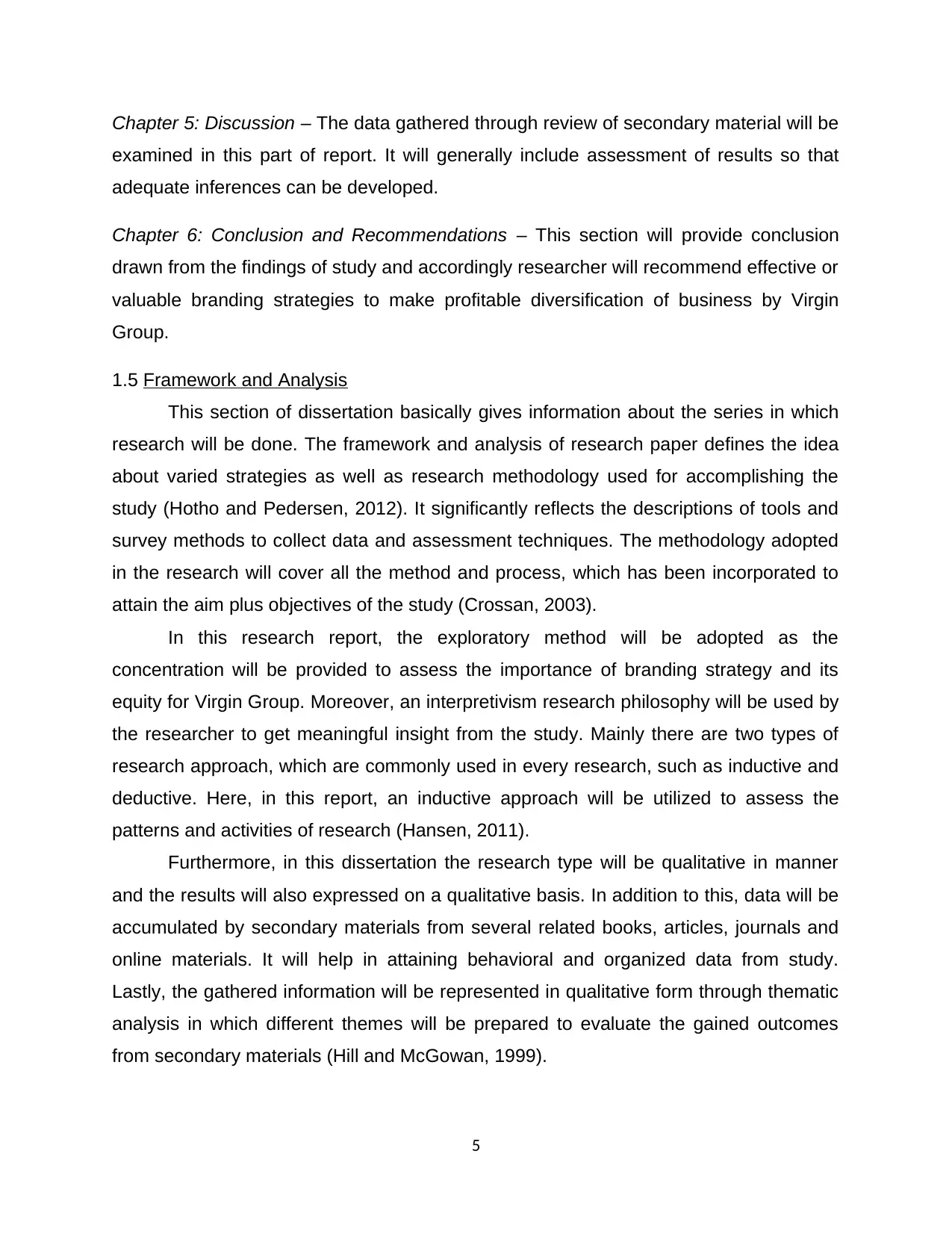
Chapter 5: Discussion – The data gathered through review of secondary material will be
examined in this part of report. It will generally include assessment of results so that
adequate inferences can be developed.
Chapter 6: Conclusion and Recommendations – This section will provide conclusion
drawn from the findings of study and accordingly researcher will recommend effective or
valuable branding strategies to make profitable diversification of business by Virgin
Group.
1.5 Framework and Analysis
This section of dissertation basically gives information about the series in which
research will be done. The framework and analysis of research paper defines the idea
about varied strategies as well as research methodology used for accomplishing the
study (Hotho and Pedersen, 2012). It significantly reflects the descriptions of tools and
survey methods to collect data and assessment techniques. The methodology adopted
in the research will cover all the method and process, which has been incorporated to
attain the aim plus objectives of the study (Crossan, 2003).
In this research report, the exploratory method will be adopted as the
concentration will be provided to assess the importance of branding strategy and its
equity for Virgin Group. Moreover, an interpretivism research philosophy will be used by
the researcher to get meaningful insight from the study. Mainly there are two types of
research approach, which are commonly used in every research, such as inductive and
deductive. Here, in this report, an inductive approach will be utilized to assess the
patterns and activities of research (Hansen, 2011).
Furthermore, in this dissertation the research type will be qualitative in manner
and the results will also expressed on a qualitative basis. In addition to this, data will be
accumulated by secondary materials from several related books, articles, journals and
online materials. It will help in attaining behavioral and organized data from study.
Lastly, the gathered information will be represented in qualitative form through thematic
analysis in which different themes will be prepared to evaluate the gained outcomes
from secondary materials (Hill and McGowan, 1999).
5
examined in this part of report. It will generally include assessment of results so that
adequate inferences can be developed.
Chapter 6: Conclusion and Recommendations – This section will provide conclusion
drawn from the findings of study and accordingly researcher will recommend effective or
valuable branding strategies to make profitable diversification of business by Virgin
Group.
1.5 Framework and Analysis
This section of dissertation basically gives information about the series in which
research will be done. The framework and analysis of research paper defines the idea
about varied strategies as well as research methodology used for accomplishing the
study (Hotho and Pedersen, 2012). It significantly reflects the descriptions of tools and
survey methods to collect data and assessment techniques. The methodology adopted
in the research will cover all the method and process, which has been incorporated to
attain the aim plus objectives of the study (Crossan, 2003).
In this research report, the exploratory method will be adopted as the
concentration will be provided to assess the importance of branding strategy and its
equity for Virgin Group. Moreover, an interpretivism research philosophy will be used by
the researcher to get meaningful insight from the study. Mainly there are two types of
research approach, which are commonly used in every research, such as inductive and
deductive. Here, in this report, an inductive approach will be utilized to assess the
patterns and activities of research (Hansen, 2011).
Furthermore, in this dissertation the research type will be qualitative in manner
and the results will also expressed on a qualitative basis. In addition to this, data will be
accumulated by secondary materials from several related books, articles, journals and
online materials. It will help in attaining behavioral and organized data from study.
Lastly, the gathered information will be represented in qualitative form through thematic
analysis in which different themes will be prepared to evaluate the gained outcomes
from secondary materials (Hill and McGowan, 1999).
5
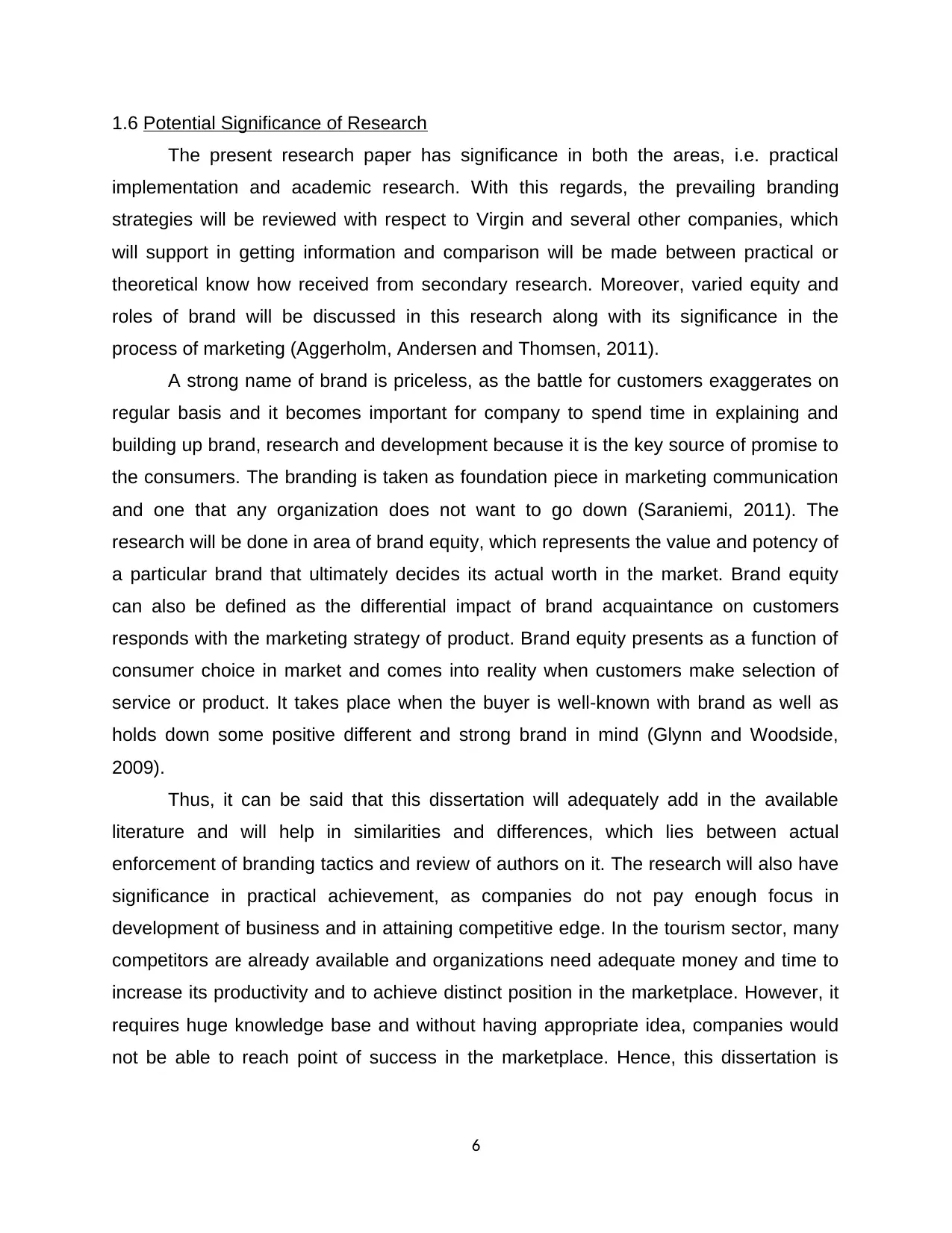
1.6 Potential Significance of Research
The present research paper has significance in both the areas, i.e. practical
implementation and academic research. With this regards, the prevailing branding
strategies will be reviewed with respect to Virgin and several other companies, which
will support in getting information and comparison will be made between practical or
theoretical know how received from secondary research. Moreover, varied equity and
roles of brand will be discussed in this research along with its significance in the
process of marketing (Aggerholm, Andersen and Thomsen, 2011).
A strong name of brand is priceless, as the battle for customers exaggerates on
regular basis and it becomes important for company to spend time in explaining and
building up brand, research and development because it is the key source of promise to
the consumers. The branding is taken as foundation piece in marketing communication
and one that any organization does not want to go down (Saraniemi, 2011). The
research will be done in area of brand equity, which represents the value and potency of
a particular brand that ultimately decides its actual worth in the market. Brand equity
can also be defined as the differential impact of brand acquaintance on customers
responds with the marketing strategy of product. Brand equity presents as a function of
consumer choice in market and comes into reality when customers make selection of
service or product. It takes place when the buyer is well-known with brand as well as
holds down some positive different and strong brand in mind (Glynn and Woodside,
2009).
Thus, it can be said that this dissertation will adequately add in the available
literature and will help in similarities and differences, which lies between actual
enforcement of branding tactics and review of authors on it. The research will also have
significance in practical achievement, as companies do not pay enough focus in
development of business and in attaining competitive edge. In the tourism sector, many
competitors are already available and organizations need adequate money and time to
increase its productivity and to achieve distinct position in the marketplace. However, it
requires huge knowledge base and without having appropriate idea, companies would
not be able to reach point of success in the marketplace. Hence, this dissertation is
6
The present research paper has significance in both the areas, i.e. practical
implementation and academic research. With this regards, the prevailing branding
strategies will be reviewed with respect to Virgin and several other companies, which
will support in getting information and comparison will be made between practical or
theoretical know how received from secondary research. Moreover, varied equity and
roles of brand will be discussed in this research along with its significance in the
process of marketing (Aggerholm, Andersen and Thomsen, 2011).
A strong name of brand is priceless, as the battle for customers exaggerates on
regular basis and it becomes important for company to spend time in explaining and
building up brand, research and development because it is the key source of promise to
the consumers. The branding is taken as foundation piece in marketing communication
and one that any organization does not want to go down (Saraniemi, 2011). The
research will be done in area of brand equity, which represents the value and potency of
a particular brand that ultimately decides its actual worth in the market. Brand equity
can also be defined as the differential impact of brand acquaintance on customers
responds with the marketing strategy of product. Brand equity presents as a function of
consumer choice in market and comes into reality when customers make selection of
service or product. It takes place when the buyer is well-known with brand as well as
holds down some positive different and strong brand in mind (Glynn and Woodside,
2009).
Thus, it can be said that this dissertation will adequately add in the available
literature and will help in similarities and differences, which lies between actual
enforcement of branding tactics and review of authors on it. The research will also have
significance in practical achievement, as companies do not pay enough focus in
development of business and in attaining competitive edge. In the tourism sector, many
competitors are already available and organizations need adequate money and time to
increase its productivity and to achieve distinct position in the marketplace. However, it
requires huge knowledge base and without having appropriate idea, companies would
not be able to reach point of success in the marketplace. Hence, this dissertation is
6
⊘ This is a preview!⊘
Do you want full access?
Subscribe today to unlock all pages.

Trusted by 1+ million students worldwide
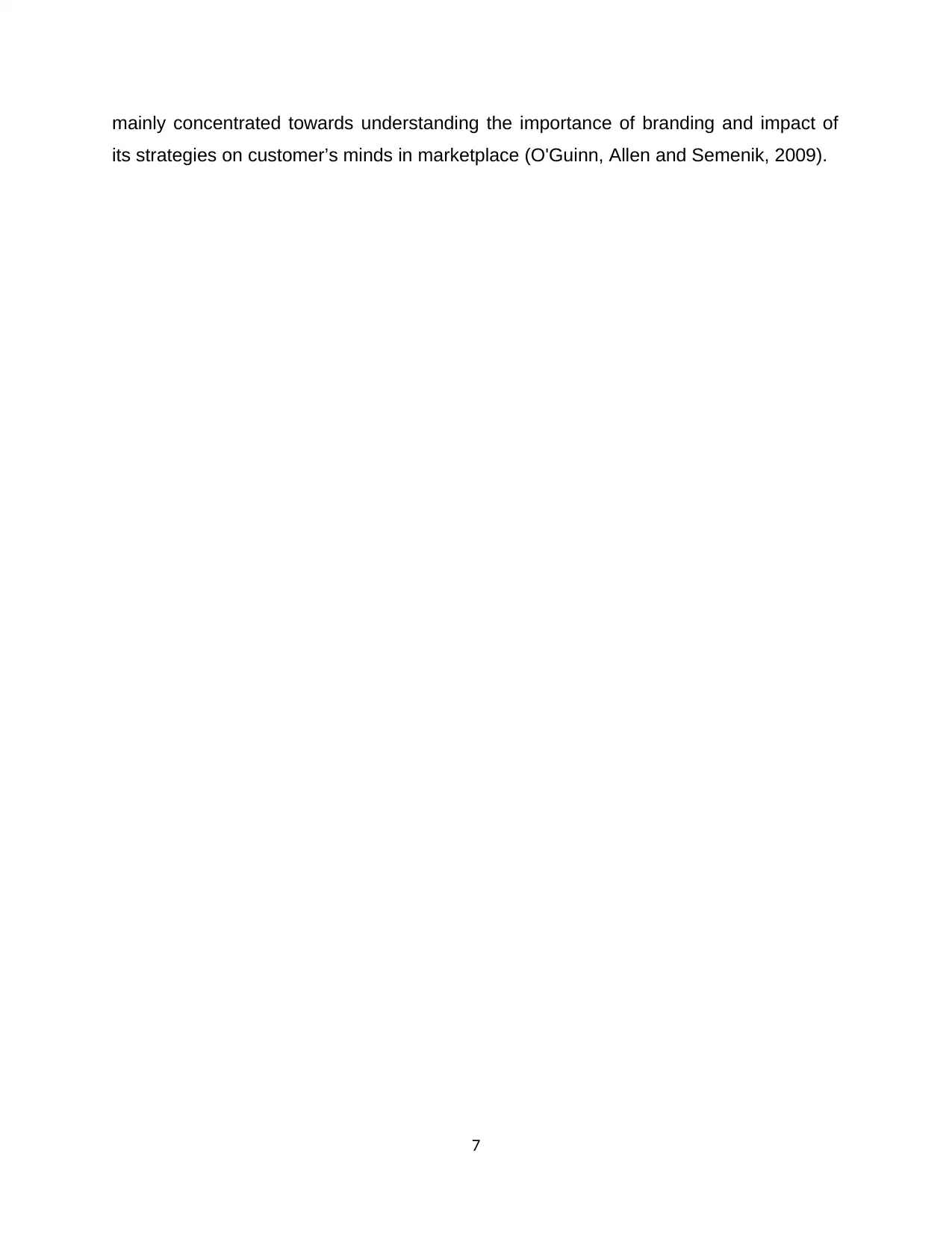
mainly concentrated towards understanding the importance of branding and impact of
its strategies on customer’s minds in marketplace (O'Guinn, Allen and Semenik, 2009).
7
its strategies on customer’s minds in marketplace (O'Guinn, Allen and Semenik, 2009).
7
Paraphrase This Document
Need a fresh take? Get an instant paraphrase of this document with our AI Paraphraser

Chapter 2- Literature Review
8
8

Chapter 3 – Case Study
9
9
⊘ This is a preview!⊘
Do you want full access?
Subscribe today to unlock all pages.

Trusted by 1+ million students worldwide
1 out of 17
Related Documents
Your All-in-One AI-Powered Toolkit for Academic Success.
+13062052269
info@desklib.com
Available 24*7 on WhatsApp / Email
![[object Object]](/_next/static/media/star-bottom.7253800d.svg)
Unlock your academic potential
Copyright © 2020–2025 A2Z Services. All Rights Reserved. Developed and managed by ZUCOL.





